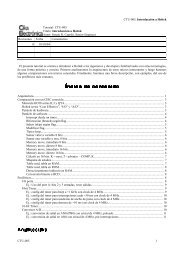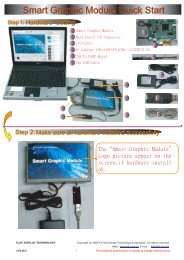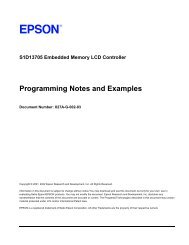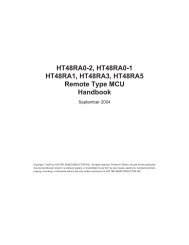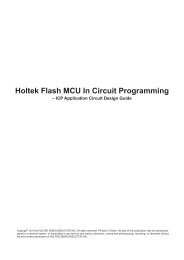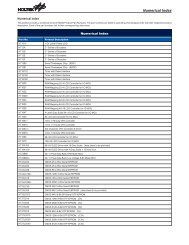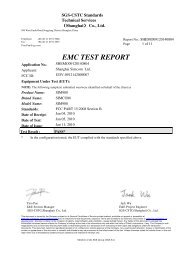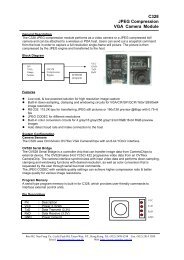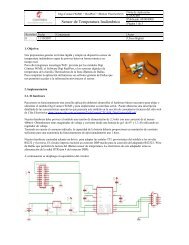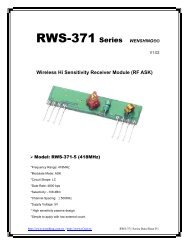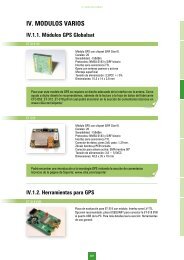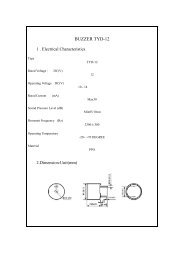HT24LC16 CMOS 16K 2-Wire Serial EEPROM
HT24LC16 CMOS 16K 2-Wire Serial EEPROM
HT24LC16 CMOS 16K 2-Wire Serial EEPROM
Create successful ePaper yourself
Turn your PDF publications into a flip-book with our unique Google optimized e-Paper software.
<strong>HT24LC16</strong><br />
<strong>CMOS</strong> <strong>16K</strong> 2-<strong>Wire</strong> <strong>Serial</strong> <strong>EEPROM</strong><br />
Features<br />
<br />
<br />
<br />
<br />
<br />
<br />
Operating voltage: 2.2V~5.5V<br />
Low power consumption<br />
Operation: 5mA max.<br />
Standby: 5A max.<br />
Internal organization: 20488<br />
2-wire <strong>Serial</strong> Interface<br />
Write cycle time: 5ms max.<br />
Automatic erase-before-write operation<br />
<br />
<br />
<br />
<br />
<br />
<br />
<br />
<br />
Partial page write allowed<br />
16-byte Page Write Mode<br />
Write operation with built-in timer<br />
Hardware controlled write protection<br />
40-year data retention<br />
10 6 rewrite cycles per word<br />
Commercial temperature range (0C to+70C)<br />
8-pin DIP/SOP/TSSOP package<br />
General Description<br />
The <strong>HT24LC16</strong> is an <strong>16K</strong>-bit serial read/write<br />
non-volatile memory device using the <strong>CMOS</strong> floating<br />
gate process. Its 16384 bits of memory are organized<br />
into 2048 words and each word is 8 bits. The device is<br />
optimized for use in many industrial and commercial applications<br />
where low power and low voltage operation<br />
are essential. Up to only one <strong>HT24LC16</strong> device may be<br />
connected to the same 2-wire bus. The <strong>HT24LC16</strong> is<br />
guaranteed for 1M erase/write cycles and 40-year data<br />
retention.<br />
Block Diagram<br />
Pin Assignment<br />
5 + <br />
5 , )<br />
9 2<br />
1<br />
+ JH <br />
C E<br />
A HO<br />
+ JH <br />
C E<br />
:<br />
,<br />
-<br />
+<br />
0 8 2 K F<br />
- - 2 4 <br />
) HH= O<br />
2 = C A * K BBA H<br />
; , - +<br />
) <br />
) <br />
)<br />
8 5 5<br />
<br />
!<br />
"<br />
&<br />
%<br />
$<br />
#<br />
8 + +<br />
9 2<br />
5 + <br />
5 , )<br />
0 6 " + $<br />
& , 12 ) 5 2 ) 6 5 5 2 )<br />
) )<br />
) @ @ HA I I<br />
+ K JA H<br />
5 A I A ) 2<br />
4 9 + JH <br />
8 + +<br />
8 5 5<br />
Pin Description<br />
Pin Name I/O Description<br />
A0~A2 I Address input<br />
SDA I/O <strong>Serial</strong> data<br />
SCL I <strong>Serial</strong> clock input<br />
WP I Write protect<br />
VSS Negative power supply, ground<br />
VCC Positive power supply<br />
Rev. 1.40 1 December 7, 2007
<strong>HT24LC16</strong><br />
Absolute Maximum Ratings<br />
Operating Temperature (Commercial) ........................................................................................................ 0Cto70C<br />
Storage Temperature ............................................................................................................................ 50Cto125C<br />
Applied VCC Voltage with Respect to VSS ............................................................................................... 0.3V to 6.0V<br />
Applied Voltage on any Pin with Respect to VSS ........................................................................................................ 0.3V to V CC +0.3V<br />
Note: These are stress ratings only. Stresses exceeding the range specified under Absolute Maximum Ratings may<br />
cause substantial damage to the device. Functional operation of this device at other conditions beyond those<br />
listed in the specification is not implied and prolonged exposure to extreme conditions may affect device reliability.<br />
D.C. Characteristics<br />
Ta=0C to70C<br />
Symbol<br />
Parameter<br />
V CC<br />
Test Conditions<br />
Conditions<br />
Min. Typ. Max. Unit<br />
V CC Operating Voltage 2.2 5.5 V<br />
I CC1 Operating Current 5V Read at 100kHz 2 mA<br />
I CC2 Operating Current 5V Write at 100kHz 5 mA<br />
V IL Input Low Voltage 1 0.3V CC V<br />
V IH Input High Voltage 0.7V CC V CC +0.5 V<br />
V OL Output Low Voltage 2.4V I OL =2.1mA 0.4 V<br />
I LI Input Leakage Current 5V V IN =0 or V CC 1 A<br />
I LO Output Leakage Current 5V V OUT =0 or V CC 1 A<br />
I STB1 Standby Current 5V V IN =0 or V CC 5 A<br />
I STB2 Standby Current 2.4V V IN =0 or V CC 4 A<br />
C IN Input Capacitance (See Note) f=1MHz 25C 6 pF<br />
C OUT Output Capacitance (See Note) f=1MHz 25C 8 pF<br />
Note: These parameters are periodically sampled but not 100% tested<br />
A.C. Characteristics<br />
Ta=0C to70C<br />
Symbol Parameter Remark<br />
Standard Mode* V CC =5V10%<br />
Unit<br />
Min. Max. Min. Max.<br />
f SK Clock Frequency 100 400 kHz<br />
t HIGH Clock High Time 4000 600 ns<br />
t LOW Clock Low Time 4700 1200 ns<br />
t r SDA and SCL Rise Time Note 1000 300 ns<br />
t f SDA and SCL Fall Time Note 300 300 ns<br />
t HD:STA<br />
START Condition Hold Time<br />
After this period the first<br />
clock pulse is generated<br />
4000 600 ns<br />
t SU:STA START Condition Setup Time<br />
Only relevant for repeated<br />
START condition<br />
4000 600 ns<br />
t HD:DAT Data Input Hold Time 0 0 ns<br />
t SU:DAT Data Input Setup Time 200 100 ns<br />
t SU:STO STOP Condition Setup Time 4000 600 ns<br />
Rev. 1.40 2 December 7, 2007
<strong>HT24LC16</strong><br />
Symbol Parameter Remark<br />
Standard Mode* V CC =5V10%<br />
Unit<br />
Min. Max. Min. Max.<br />
t AA Output Valid from Clock 3500 900 ns<br />
t BUF<br />
Bus Free Time<br />
Time in which the bus must be<br />
free before a new transmission<br />
can start<br />
4700 1200 ns<br />
t SP<br />
Input Filter Time Constant<br />
(SDA and SCL Pins)<br />
Noise suppression time 100 50 ns<br />
t WR Write Cycle Time 5 5 ms<br />
Notes: These parameters are periodically sampled but not 100% tested<br />
* The standard mode means V CC =2.2V to 5.5V<br />
For relative timing, refer to timing diagrams<br />
Functional Description<br />
<strong>Serial</strong> clock (SCL)<br />
The SCL input is used for positive edge clock data into<br />
each <strong>EEPROM</strong> device and negative edge clock data<br />
out of each device.<br />
<strong>Serial</strong> data (SDA)<br />
The SDA pin is bidirectional for serial data transfer.<br />
The pin is open drain driven and may be wired-OR<br />
with any number of other open drain or open collector<br />
devices.<br />
A0, A1, A2<br />
The <strong>HT24LC16</strong> does not use the device address pins<br />
which limits the number of devices on a single bus to<br />
one. The A0, A1 and A2 pins have no connection.<br />
Write protect (WP)<br />
The <strong>HT24LC16</strong> has a write protect pin that provides<br />
hardware data protection. The write protect pin allows<br />
normal read/write operations when the connection is<br />
grounded. When the write protect pin is connected to<br />
V CC , the write protection feature is enabled and operates<br />
as shown in the following table.<br />
WP Pin Status<br />
Protect Array<br />
At V CC<br />
Full Array (<strong>16K</strong>)<br />
At V SS<br />
Normal Read/Write Operations<br />
Memory Organization<br />
Internally organized with 2048 8-bit words, the <strong>16K</strong> requires<br />
an 11-bit data word address for random word addressing.<br />
Device Operations<br />
Clock and data transition<br />
Data transfer may be initiated only when the bus is not<br />
busy. During data transfer, the data line must remain<br />
stable whenever the clock line is high. Changes in<br />
data line while the clock line is high will be interpreted<br />
as a START or STOP condition.<br />
Start condition<br />
A high-to-low transition of SDA with SCL high is a start<br />
condition which must precede any other command<br />
(refer to Start and Stop Definition Timing diagram).<br />
Stop condition<br />
A low-to-high transition of SDA with SCL high is a stop<br />
condition. After a read sequence, the stop command<br />
will place the <strong>EEPROM</strong> in a standby power mode (refer<br />
to Start and Stop Definition Timing Diagram).<br />
Acknowledge<br />
All addresses and data words are serially transmitted<br />
to and from the <strong>EEPROM</strong> in 8-bit words. The<br />
<strong>EEPROM</strong> sends a zero to acknowledge that it has received<br />
each word. This happens during the ninth clock<br />
cycle.<br />
5 , )<br />
5 + <br />
5 J= HJ<br />
@ EJE <br />
, = J= = M A @<br />
J D = C A<br />
) @ @ HA I I H<br />
= M A @ C A<br />
L = E@<br />
) + <br />
I J= JA<br />
5 J F<br />
@ EJE <br />
Device Addressing<br />
The <strong>16K</strong> <strong>EEPROM</strong> devices require an 8-bit device address<br />
word following a start condition to enable the chip<br />
for a read or write operation. The device address word<br />
consist of a mandatory one, zero sequence for the first<br />
four most significant bits (refer to the diagram showing<br />
the Device Address). This is common to all the<br />
<strong>EEPROM</strong> device.<br />
The <strong>16K</strong> does not use any device address bits but instead<br />
the 3 bits are used for memory page addressing.<br />
These page addressing bits on the <strong>16K</strong> devices should<br />
be considered the most significant bits of the data word<br />
address which follows. The A0, A1 and A2 pins have no<br />
connection.<br />
Rev. 1.40 3 December 7, 2007
<strong>HT24LC16</strong><br />
The 8th bit device address is the read/write operation<br />
select bit. A read operation is initiated if this bit is high<br />
and a write operation is initiated if this bit is low.<br />
If the comparison of the device address succeed the<br />
<strong>EEPROM</strong> will output a zero at ACK bit. If not, the chip will<br />
return to a standby state.<br />
) ) ) <br />
, A L E A ) @ @ HA I I<br />
4 9<br />
Acknowledge polling<br />
To maximize bus throughput, one technique is to allow<br />
the master to poll for an acknowledge signal after the<br />
start condition and the control byte for a write command<br />
have been sent. If the device is still busy implementing<br />
its write cycle, then no ACK will be returned.<br />
The master can send the next read/write command<br />
when the ACK signal has finally been received.<br />
5 A @ 9 HEJA + = @<br />
Write Operations<br />
Byte write<br />
A write operation requires an 8-bit data word address<br />
following the device address word and acknowledgment.<br />
Upon receipt of this address, the <strong>EEPROM</strong> will<br />
again respond with a zero and then clock in the first<br />
8-bit data word. After receiving the 8-bit data word, the<br />
<strong>EEPROM</strong> will output a zero and the addressing device,<br />
such as a microcontroller, must terminate the<br />
write sequence with a stop condition. At this time the<br />
<strong>EEPROM</strong> enters an internally-timed write cycle to the<br />
nonvolatile memory. All inputs are disabled during this<br />
write cycle and <strong>EEPROM</strong> will not respond until write is<br />
complete (refer to Byte write timing).<br />
Page write<br />
The <strong>16K</strong> <strong>EEPROM</strong> is capable of a 16-byte page write.<br />
A page write is initiated in the same way as a byte<br />
write, but the microcontroller does not send a stop condition<br />
after the first data word is clocked in. Instead, after<br />
the <strong>EEPROM</strong> acknowledges the receipt of the first<br />
data word, the microcontroller can transmit up to 15<br />
more data words. The <strong>EEPROM</strong> will respond with a<br />
zero after each data word received. The<br />
microcontroller must terminate the page write sequence<br />
with a stop condition (refer to Page write timing).<br />
The data word address lower four bits are internally incremented<br />
following the receipt of each data word.<br />
The higher data word address bits are not incremented,<br />
retaining the memory page row location.<br />
5 A @ 5 J F + @ EJE <br />
J 1 EJE= JA 9 HEJA + O A<br />
5 A @ 5 J= HJ<br />
5 A @ + JH * O JA<br />
M EJD 4 9 <br />
) + <br />
; A I<br />
A N J F A H= JE <br />
Write protect<br />
The <strong>HT24LC16</strong> has a write-protect function and programming<br />
will then be inhibited when the WP pin is<br />
connected to VCC. Under this mode, the <strong>HT24LC16</strong> is<br />
used as a serial ROM.<br />
Read operations<br />
The <strong>HT24LC16</strong> supports three read operations,<br />
namely, current address read, random address read<br />
and sequential read. During read operation execution,<br />
the read/write select bit should be set to 1.<br />
<br />
Acknowledge Polling Flow<br />
, A L E A = @ @ HA I I 9 H@ = @ @ HA I I , ) 6 )<br />
5 , )<br />
5 ) ) ) <br />
2<br />
5 J= HJ<br />
4 9<br />
) + ) + <br />
) + <br />
5 J F<br />
Byte Write Timing<br />
, A L E A = @ @ HA I I 9 H@ = @ @ HA I I , ) 6 ) <br />
, ) 6 ) , ) 6 ) N<br />
5 , )<br />
5<br />
2<br />
) + ) + <br />
5 J F<br />
5 J= HJ<br />
) + <br />
) + <br />
Page Write Timing<br />
Rev. 1.40 4 December 7, 2007
<strong>HT24LC16</strong><br />
Current address read<br />
The internal data word address counter maintains the<br />
last address accessed during the last read or write operation,<br />
incremented by one. This address stays valid<br />
between operations as long as the chip power is maintained.<br />
The address roll over during read from the last<br />
byte of the last memory page to the first byte of the first<br />
page. The address roll over during write from the last<br />
byte of the current page to the first byte of the same<br />
page. Once the device address with the read/write select<br />
bit set to one is clocked in and acknowledged by<br />
the <strong>EEPROM</strong>, the current address data word is serially<br />
clocked out. The microcontroller should respond<br />
with a no ACK signal (high) followed by a stop condition<br />
(refer to Current read timing).<br />
Sequential read<br />
Sequential reads are initiated by either a current address<br />
read or a random address read. After the<br />
microcontroller receives a data word, it responds with<br />
an acknowledgment. As long as the <strong>EEPROM</strong> receives<br />
an acknowledgment, it will continue to increment<br />
the data word address and serially clock out<br />
sequential data words. When the memory address<br />
limit is reached, the data word address will roll over<br />
and the sequential read continues. The sequential<br />
read operation is terminated when the microcontroller<br />
responds with a no ACK signal (high) followed by a<br />
stop condition.<br />
Random read<br />
A random read requires a dummy byte write sequence<br />
to load in the data word address which is then clocked<br />
in and acknowledged by the <strong>EEPROM</strong>. The<br />
microcontroller must then generate another start condition.<br />
The microcontroller now initiates a current address<br />
read by sending a device address with the<br />
read/write select bit high. The <strong>EEPROM</strong> acknowledges<br />
the device address and serially clocks out the<br />
data word. The microcontroller should respond with a<br />
no ACK signal (high) followed by a stop condition<br />
(refer to Random read timing).<br />
5 , )<br />
, A L E A = @ @ HA I I , ) 6 )<br />
5 J F<br />
5 ) ) ) <br />
2<br />
5 J= HJ<br />
) + <br />
) + <br />
Current Read Timing<br />
5 , )<br />
5<br />
, A L E A = @ @ HA I I 9 H@ = @ @ HA I I<br />
) ) ) <br />
) + <br />
5 J= HJ<br />
, A L E A = @ @ HA I I<br />
5<br />
) + <br />
5 J= HJ<br />
, ) 6 )<br />
5 J F<br />
2<br />
) + ) + <br />
Random Read Timing<br />
, A L E A = @ @ HA I I , ) 6 ) <br />
, ) 6 ) , ) 6 ) N<br />
5 J F<br />
5 , )<br />
5<br />
5 J= HJ<br />
) + <br />
) + <br />
2<br />
) + <br />
Sequential Read Timing<br />
Rev. 1.40 5 December 7, 2007
<strong>HT24LC16</strong><br />
Timing Diagrams<br />
J.<br />
J4<br />
J0 1/ 0<br />
5 + <br />
J 9<br />
J5 7 5 6 ) J0 , 5 6 )<br />
J0 , , ) 6<br />
J5 7 , ) 6<br />
J5 7 5 6 <br />
5 , )<br />
5 , )<br />
7 6<br />
J5 2<br />
J) )<br />
8 = E@ 8 = E@<br />
J* 7 .<br />
5 + <br />
5 , ) & JD > EJ ) + <br />
9 H@ <br />
5 J F<br />
+ @ EJE <br />
J9 4<br />
5 J= HJ<br />
+ @ EJE <br />
Note: The write cycle time t WR is the time from a valid stop condition of a write sequence to the end of the valid start condition<br />
of sequential command.<br />
Rev. 1.40 6 December 7, 2007
<strong>HT24LC16</strong><br />
Package Information<br />
8-pin DIP (300mil) Outline Dimensions<br />
)<br />
<br />
*<br />
& #<br />
"<br />
0<br />
+<br />
,<br />
-<br />
/<br />
=<br />
1<br />
.<br />
Symbol<br />
Dimensions in mil<br />
Min. Nom. Max.<br />
A 355 375<br />
B 240 260<br />
C 125 135<br />
D 125 145<br />
E 16 20<br />
F 50 70<br />
G 100 <br />
H 295 315<br />
I 335 375<br />
0 15<br />
Rev. 1.40 7 December 7, 2007
<strong>HT24LC16</strong><br />
8-pin SOP (150mil) Outline Dimensions<br />
& #<br />
) *<br />
"<br />
+<br />
,<br />
+ <br />
/<br />
0<br />
-<br />
.<br />
=<br />
Symbol<br />
Dimensions in mil<br />
Min. Nom. Max.<br />
A 228 244<br />
B 149 157<br />
C 14 20<br />
C 189 197<br />
D 53 69<br />
E 50 <br />
F 4 10<br />
G 22 28<br />
H 4 12<br />
0 10<br />
Rev. 1.40 8 December 7, 2007
<strong>HT24LC16</strong><br />
8-pin TSSOP Outline Dimensions<br />
&<br />
#<br />
- <br />
"<br />
,<br />
)<br />
A * ) <br />
4 O<br />
" + 4 - 4 5 <br />
)<br />
<br />
-<br />
+ G<br />
<br />
Symbol<br />
Dimensions in mm<br />
Min. Nom. Max.<br />
A 1.05 1.20<br />
A1 0.05 0.15<br />
A2 0.95 1.05<br />
B 0.25 <br />
C 0.11 0.15<br />
D 2.90 3.10<br />
E 6.20 6.60<br />
E1 4.30 4.50<br />
e 0.65 <br />
L 0.50 0.70<br />
L1 0.90 1.10<br />
y 0.10<br />
0 8<br />
Rev. 1.40 9 December 7, 2007
<strong>HT24LC16</strong><br />
Product Tape and Reel Specifications<br />
Reel Dimensions<br />
6<br />
,<br />
) *<br />
+<br />
6 <br />
SOP 8N, TSSOP 8L<br />
Symbol Description Dimensions in mm<br />
A Reel Outer Diameter 3301.0<br />
B Reel Inner Diameter 621.5<br />
C<br />
Spindle Hole Diameter<br />
13.0+0.5<br />
0.2<br />
D Key Slit Width 2.00.5<br />
T1<br />
Space Between Flange<br />
12.8+0.3<br />
0.2<br />
T2 Reel Thickness 18.20.2<br />
Rev. 1.40 10 December 7, 2007
<strong>HT24LC16</strong><br />
Carrier Tape Dimensions<br />
,<br />
2 <br />
2 <br />
J<br />
-<br />
.<br />
9<br />
+<br />
* <br />
, <br />
2<br />
<br />
) <br />
SOP 8N<br />
Symbol Description Dimensions in mm<br />
W Carrier Tape Width<br />
12.0+0.3<br />
0.1<br />
P Cavity Pitch 8.00.1<br />
E Perforation Position 1.750.1<br />
F Cavity to Perforation (Width Direction) 5.50.1<br />
D Perforation Diameter 1.550.1<br />
D1 Cavity Hole Diameter 1.5+0.25<br />
P0 Perforation Pitch 4.00.1<br />
P1 Cavity to Perforation (Length Direction) 2.00.1<br />
A0 Cavity Length 6.40.1<br />
B0 Cavity Width 5.20.1<br />
K0 Cavity Depth 2.10.1<br />
t Carrier Tape Thickness 0.30.05<br />
C Cover Tape Width 9.3<br />
TSSOP 8L<br />
Symbol Description Dimensions in mm<br />
W Carrier Tape Width<br />
12.0+0.3<br />
0.1<br />
P Cavity Pitch 8.00.1<br />
E Perforation Position 1.750.1<br />
F Cavity to Perforation (Width Direction) 5.50.5<br />
D Perforation Diameter 1.5+0.1<br />
D1 Cavity Hole Diameter 1.5+0.1<br />
P0 Perforation Pitch 4.00.1<br />
P1 Cavity to Perforation (Length Direction) 2.00.1<br />
A0 Cavity Length 7.00.1<br />
B0 Cavity Width 3.60.1<br />
K0 Cavity Depth 1.60.1<br />
t Carrier Tape Thickness 0.30.013<br />
C Cover Tape Width 9.3<br />
Rev. 1.40 11 December 7, 2007
<strong>HT24LC16</strong><br />
Holtek Semiconductor Inc. (Headquarters)<br />
No.3, Creation Rd. II, Science Park, Hsinchu, Taiwan<br />
Tel: 886-3-563-1999<br />
Fax: 886-3-563-1189<br />
http://www.holtek.com.tw<br />
Holtek Semiconductor Inc. (Taipei Sales Office)<br />
4F-2, No. 3-2, YuanQu St., Nankang Software Park, Taipei 115, Taiwan<br />
Tel: 886-2-2655-7070<br />
Fax: 886-2-2655-7373<br />
Fax: 886-2-2655-7383 (International sales hotline)<br />
Holtek Semiconductor Inc. (Shanghai Sales Office)<br />
7th Floor, Building 2, No.889, Yi Shan Rd., Shanghai, China 200233<br />
Tel: 86-21-6485-5560<br />
Fax: 86-21-6485-0313<br />
http://www.holtek.com.cn<br />
Holtek Semiconductor Inc. (Shenzhen Sales Office)<br />
5/F, Unit A, Productivity Building, Cross of Science M 3rd Road and Gaoxin M 2nd Road, Science Park, Nanshan District,<br />
Shenzhen, China 518057<br />
Tel: 86-755-8616-9908, 86-755-8616-9308<br />
Fax: 86-755-8616-9722<br />
Holtek Semiconductor Inc. (Beijing Sales Office)<br />
Suite 1721, Jinyu Tower, A129 West Xuan Wu Men Street, Xicheng District, Beijing, China 100031<br />
Tel: 86-10-6641-0030, 86-10-6641-7751, 86-10-6641-7752<br />
Fax: 86-10-6641-0125<br />
Holtek Semiconductor Inc. (Chengdu Sales Office)<br />
709, Building 3, Champagne Plaza, No.97 Dongda Street, Chengdu, Sichuan, China 610016<br />
Tel: 86-28-6653-6590<br />
Fax: 86-28-6653-6591<br />
Holtek Semiconductor (USA), Inc. (North America Sales Office)<br />
46729 Fremont Blvd., Fremont, CA 94538<br />
Tel: 1-510-252-9880<br />
Fax: 1-510-252-9885<br />
http://www.holtek.com<br />
Copyright 2007 by HOLTEK SEMICONDUCTOR INC.<br />
The information appearing in this Data Sheet is believed to be accurate at the time of publication. However, Holtek assumes<br />
no responsibility arising from the use of the specifications described. The applications mentioned herein are used<br />
solely for the purpose of illustration and Holtek makes no warranty or representation that such applications will be suitable<br />
without further modification, nor recommends the use of its products for application that may present a risk to human life<br />
due to malfunction or otherwise. Holteks products are not authorized for use as critical components in life support devices<br />
or systems. Holtek reserves the right to alter its products without prior notification. For the most up-to-date information,<br />
please visit our web site at http://www.holtek.com.tw.<br />
Rev. 1.40 12 December 7, 2007



